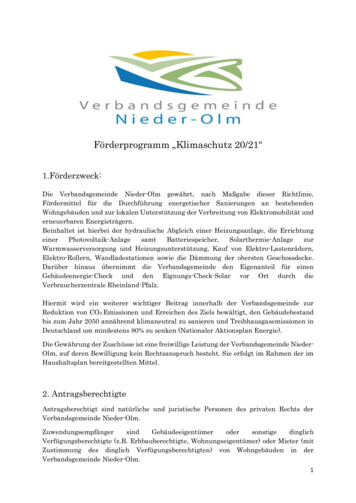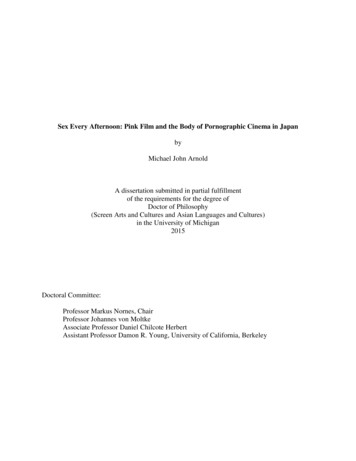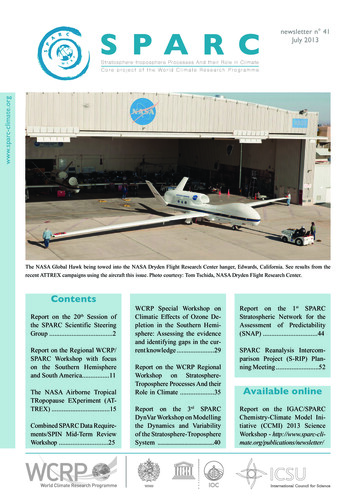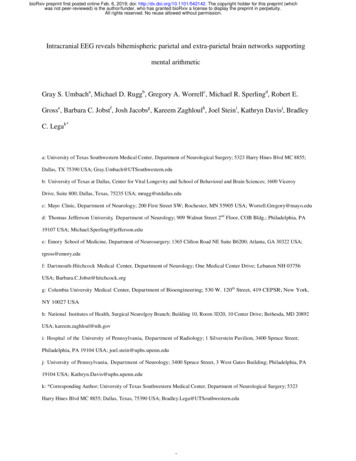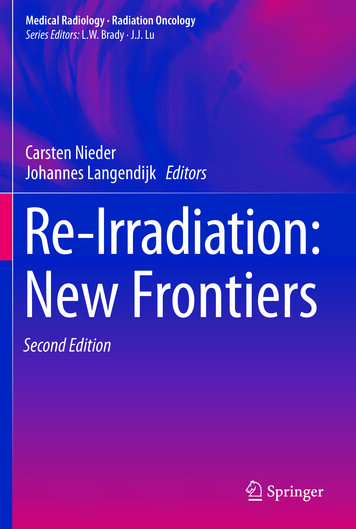
Transcription
Medical Radiology · Radiation OncologySeries Editors: L.W. Brady · J.J. LuCarsten NiederJohannes Langendijk EditorsRe-Irradiation:New FrontiersSecond Edition
Medical RadiologyRadiation OncologySeries editorsLuther W. BradyJiade J. LuHonorary editorsHans-Peter HeilmannMichael MollsFor further volumes:http://www.springer.com/series/4353
Carsten Nieder Johannes LangendijkEditorsRe-Irradiation:New FrontiersSecond Edition
EditorsCarsten NiederDepartment of OncologyUniversity of Tromso and NordlandHospitalBodoNorwayJohannes LangendijkUniversity Medical Center GroningenGroningenThe NetherlandsISSN 0942-5373 ISSN 2197-4187 (electronic)Radiation OncologyISBN 978-3-319-41823-0 ISBN 978-3-319-41825-4 (eBook)DOI 10.1007/978-3-319-41825-4Library of Congress Control Number: 2016956621 Springer International Publishing 2017This work is subject to copyright. All rights are reserved by the Publisher, whether the whole orpart of the material is concerned, specifically the rights of translation, reprinting, reuse ofillustrations, recitation, broadcasting, reproduction on microfilms or in any other physical way,and transmission or information storage and retrieval, electronic adaptation, computer software,or by similar or dissimilar methodology now known or hereafter developed.The use of general descriptive names, registered names, trademarks, service marks, etc. in thispublication does not imply, even in the absence of a specific statement, that such names areexempt from the relevant protective laws and regulations and therefore free for general use.The publisher, the authors and the editors are safe to assume that the advice and information inthis book are believed to be true and accurate at the date of publication. Neither the publisher northe authors or the editors give a warranty, express or implied, with respect to the materialcontained herein or for any errors or omissions that may have been made.Printed on acid-free paperThis Springer imprint is published by Springer NatureThe registered company is Springer International Publishing AGThe registered company address is Gewerbestrasse 11, 6330 Cham, Switzerland
ContentsNormal Tissue Tolerance to Reirradiation . . . . . . . . . . . . . . . . . . . .Carsten Nieder and Johannes A. Langendijk1Fractionation Concepts . . . . . . . . . . . . . . . . . . . . . . . . . . . . . . . . . . .Carsten Nieder and Michael Baumann17Hyperthermia and Reirradiation . . . . . . . . . . . . . . . . . . . . . . . . . . .Oliver J. Ott and Manfred Schmidt35Therapeutic Ratio of Reirradiation with Cytotoxic Drugsand Other Response-Modifying Agents . . . . . . . . . . . . . . . . . . . . . .Carsten Nieder and Avraham EisbruchReduced Normal Tissue Doses ThroughAdvanced Technology . . . . . . . . . . . . . . . . . . . . . . . . . . . . . . . . . . . . .Matthias Guckenberger, Reinhart A. Sweeney,Cedric Panje, and Stephanie Tanadini-Lang4775Proton Beam Reirradiation . . . . . . . . . . . . . . . . . . . . . . . . . . . . . . . .Mark W. McDonald and Kevin P. McMullen105Brain Tumours . . . . . . . . . . . . . . . . . . . . . . . . . . . . . . . . . . . . . . . . . .Joshua D. Palmer, Colin Champ, Susan C. Short,and Shannon E. Fogh127Eye Tumors . . . . . . . . . . . . . . . . . . . . . . . . . . . . . . . . . . . . . . . . . . . . .Helen A. Shih, Alexei V. Trofimov, and John E. Munzenrider143Re-irradiation in Head and Neck Cancer . . . . . . . . . . . . . . . . . . . . . 151Johannes A. LangendijkNasopharyngeal Carcinoma . . . . . . . . . . . . . . . . . . . . . . . . . . . . . . . .Wai Tong Ng, Oscar S.H. Chan, Henry C.K. Sze,and Anne W.M. Lee169Lung Cancer . . . . . . . . . . . . . . . . . . . . . . . . . . . . . . . . . . . . . . . . . . . .Branislav Jeremić, Francesc Casas, Sherif Abdel-Wahab,Nikola Cihoric, Pavol Dubinsky, Ana Mena Merino,and Luhua Wang185Re-irradiation for Esophageal Cancer . . . . . . . . . . . . . . . . . . . . . . .Stefano Arcangeli and Vittorio Donato209v
viRe-irradiation for Locally Recurrent Breast Cancer . . . . . . . . . . .Andrew O. Wahl and William Small Jr.213Prostate Cancer . . . . . . . . . . . . . . . . . . . . . . . . . . . . . . . . . . . . . . . . . .Max Peters, Metha Maenhout, Steven Frank,and Marco van Vulpen225Rectal Cancer . . . . . . . . . . . . . . . . . . . . . . . . . . . . . . . . . . . . . . . . . . .Mariangela Massaccesi and Vincenzo Valentini243Gynecological Malignancies . . . . . . . . . . . . . . . . . . . . . . . . . . . . . . . .Jennifer Croke, Eric Leung, and Anthony Fyles267Reirradiation for Soft Tissue Sarcomas . . . . . . . . . . . . . . . . . . . . . .Michael S. Rutenberg and Daniel J. Indelicato281Re-irradiation for Recurrent Skin Cancer . . . . . . . . . . . . . . . . . . . .Michael J. Veness and Puma Sundaresan293Leukemia and Lymphoma . . . . . . . . . . . . . . . . . . . . . . . . . . . . . . . . . 301Chris R. Kelsey and Grace J. KimBone Metastases . . . . . . . . . . . . . . . . . . . . . . . . . . . . . . . . . . . . . . . . .Yvette van der Linden and Peter Hoskin317Brain Metastases . . . . . . . . . . . . . . . . . . . . . . . . . . . . . . . . . . . . . . . . .Carsten Nieder, Anca L. Grosu, and Minesh P. Mehta337Erratum . . . . . . . . . . . . . . . . . . . . . . . . . . . . . . . . . . . . . . . . . . . . . . . .E1Index . . . . . . . . . . . . . . . . . . . . . . . . . . . . . . . . . . . . . . . . . . . . . . . . . . .357
ContributorsSherif Abdel-Wahab Department of Clinical Oncology, Ain ShamsUniversity, Cairo, EgyptStefano Arcangeli Department of Radiation Oncology, S. Camillo andForlanini Hospitals, Rome, ItalyMichael Baumann Department of Radiation Oncology, Faculty ofMedicine and University Hospital Carl Gustav Carus, TechnischeUniversität Dresden, Dresden, GermanyOncoRay – National Center for Radiation Research in Oncology, Faculty ofMedicine and University Hospital Carl Gustav Carus, TechnischeUniversität Dresden, Helmholtz-Zentrum Dresden – Rossendorf, Dresden,GermanyHelmholtz-Zentrum Dresden – Rossendorf, Institute od Radiooncology,Dresden, GermanyDeutsches Konsortium für Translationale Krebsforschung (DKTK), Dresdenund Deutsches Krebsforschungszentrum (DKFZ), Heidelberg, GermanyNational Center for Tumor Diseases (NCT), Partner Site Dresden, Dresden,GermanyFrancesc Casas Department of Radiation Oncology, University Clinic,Barcelona, SpainColin Champ Department of Radiation Oncology, University of PittsburghMedical Center, Pittsburgh, PA, USAOscar S.H. Chan Department of Clinical Oncology, Pamela YoudeNethersole Eastern Hospital, Hong Kong, ChinaNikola Cihoric Department of Radiation Oncology, Inselspital, Bern,SwitzerlandJennifer Croke Radiation Medicine Program, Princess Margaret CancerCentre, Toronto, ON, CanadaDepartment of Radiation Oncology, University of Toronto, Toronto, ON,Canadavii
viiiVittorio Donato Department of Radiation Oncology, S. Camillo andForlanini Hospitals, Rome, ItalyPavol Dubinsky Department of Radiation Oncology, Eastern SlovakiaUniversity, Kosice, SlovakiaAvraham Eisbruch Department of Radiation Oncology, University ofMichigan Medical Center, Ann Arbor, MI, USAShannon E. Fogh Department of Radiation Oncology, University ofCalifornia, San Francisco, CA, USASteven Frank Department of Radiotherapy, University Medical CenterUtrecht, Utrecht, The NetherlandsAnthony Fyles Radiation Medicine Program, Princess Margaret CancerCentre, Toronto, ON, CanadaDepartment of Radiation Oncology, University of Toronto, Toronto, ON,CanadaAnca L. Grosu Department of Radiation Oncology, University HospitalFreiburg, Freiburg, GermanyMatthias Guckenberger Department of Radiation Oncology, UniversityHospital Zurich, Zurich, SwitzerlandPeter Hoskin Department of Radiotherapy, Mount Vernon Hospital,London, UKDaniel J. Indelicato Department of Radiation Oncology, University ofFlorida College of Medicine, Gainesville, FL, USAUniversity of Florida Proton Therapy Institute, Jacksonville, FL, USABranislav Jeremić Department of Radiation Oncology, Institute ofPulmonary Diseases, Sremska Kamenica, SerbiaBioIRC Centre for Biomedical Research, Kragujevac, SerbiaChris R. Kelsey Department of Radiation Oncology, Duke UniversityMedical Center, Durham, NC, USAGrace J. Kim Department of Radiation Oncology, Duke UniversityMedical Center, Durham, NC, USAJohannes A. Langendijk Department of Radiation Oncology, UniversityMedical Center Groningen, University of Groningen, Groningen, TheNetherlandsAnne W.M. Lee Department of Clinical Oncology, The University of HongKong, Hong Kong, ChinaThe University of Hong Kong – Shenzhen Hospital, Hong Kong, ChinaEric Leung Department of Radiation Oncology, Odette Cancer Center,Toronto, ON, CanadaContributors
ContributorsixDepartment of Radiation Oncology, University of Toronto, Toronto, ON,CanadaMetha Maenhout Department of Radiotherapy, University Medical CenterUtrecht, Utrecht, The NetherlandsMariangela Massaccesi Radiation Oncology Department – Gemelli ART,Università Cattolica del Sacro Cuore, Rome, ItalyMark W. McDonald Department of Radiation Oncology, Winship CancerInstitute of Emory University, Atlanta, GA, USAKevin P. McMullen Department of Radiation Oncology, The CancerCenter at Columbus Regional Health, Columbus, IN, USAMinesh P. Mehta Department of Radiation Oncology, University ofMaryland School of Medicine, Baltimore, MD, USAAna Mena Merino Department of Radiation Oncology, University ofPalma de Majorca, Palma, SpainJohn E. Munzenrider Department of Radiation Oncology, MassachusettsGeneral Hospital, Boston, MA, USAWai Tong Ng Department of Clinical Oncology, Pamela Youde NethersoleEastern Hospital, Hong Kong, ChinaCarsten Nieder Department of Oncology and Palliative Medicine,Nordland Hospital, Bodø, NorwayOliver J. Ott Department of Radiation Oncology, University HospitalErlangen, Erlangen, GermanyJoshua D. Palmer Department of Radiation Oncology, JamesComprehensive Cancer Center, The Ohio State University, Columbus, Ohia,USACedric Panje Department of Radiation Oncology, University HospitalZurich, Zurich, SwitzerlandMax Peters Department of Radiotherapy, University Medical CenterUtrecht, Utrecht, The NetherlandsMichael S. Rutenberg Department of Radiation Oncology, University ofFlorida College of Medicine, Gainesville, FL, USAUniversity of Florida Proton Therapy Institute, Jacksonville, FL, USAManfred Schmidt Department of Radiation Oncology, University HospitalErlangen, Erlangen, GermanyHelen A. Shih Central Nervous System and Eye Services, Department ofRadiation Oncology, Massachusetts General Hospital, Boston, MA, USASusan C. Short UCL Cancer Institute, London, UKWilliam Small Jr. Department of Radiation Oncology, Loyola University,Cardinal Bernardin Cancer Center, Maywood, IL, USA
xPuma Sundaresan Department of Radiation Oncology, Crown PrincessMary Cancer Centre, Westmead Hospital, Westmead, NSW, AustraliaUniversity of Sydney, Sydney, NSW, AustraliaReinhart A. Sweeney Department of Radiation Oncology, LeopoldinaHospital Schweinfurt, Schweinfurt, GermanyHenry C.K. Sze Department of Clinical Oncology, Pamela YoudeNethersole Eastern Hospital, Hong Kong, ChinaStephanie Tanadini-Lang Department of Radiation Oncology, UniversityHospital Zurich, Zurich, SwitzerlandAlexei V. Trofimov Physics Division, Department of Radiation Oncology,Massachusetts General Hospital, Boston, MA, USAVincenzo Valentini Radiation Oncology Department – Gemelli ART,Università Cattolica del Sacro Cuore, Rome, ItalyMarco van Vulpen Department of Radiotherapy, University MedicalCenter Utrecht, Utrecht, The NetherlandsYvette van der Linden Department of Radiotherapy, Leiden UniversityMedical Centre, Leiden, The NetherlandsMichael J. Veness Department of Radiation Oncology, Crown PrincessMary Cancer Centre, Westmead Hospital, Westmead, NSW, AustraliaUniversity of Sydney, Sydney, NSW, AustraliaAndrew O. Wahl Department of Radiation Oncology, University ofNebraska Medical Center, Buffett Cancer Center, Omaha, NE, USALuhua Wang Department of Radiation Oncology, Chinese MedicalAcademy of Science, Beijing, ChinaContributors
The original version of this book was revised. An erratum tothis book can be found at DOI 10.1007/978-3-319-41825-4 78.
Normal Tissue Toleranceto ReirradiationCarsten Nieder and Johannes A. LangendijkContentsAbstract1 Introduction.12 Acute Reactions.2.1 Skin and Mucosa.2.2 Intestine.2223 Late Side Effects.3.1 Epithelial and Mesenchymal Tissues.3.2 Thoracic Aorta and Carotid Arteries.3.3 Intestine.3.4 Lung.3.5 Spinal Cord.3.6 Brain.3.7 Heart.3.8 Bladder.3.9 Kidney.33445591010104 Liver.105 Discussion.11References.13As a result of longer survival times, even amongpatients with incurable malignancies, the prevalence of patients at risk of developing secondprimary tumours and/or locoregional recurrences in previously irradiated areas mightincrease. Consequently, the need for additionaltherapeutic measures providing local controland/or symptom palliation along different linesof treatment has emerged. This has resulted inincreasing requests for delivering a second andsometimes even third course of radiation to target volumes within or close to previously irradiated anatomical areas. On the one hand,improved imaging and delivery techniquesincluding image-guided and intensity-modulated radiotherapy might facilitate reirradiationof previously exposed regions of the body. Onthe other hand, late toxicity is of concern becauseit often causes serious impact on health- relatedquality of life. Therefore, knowledge about longterm recovery of occult radiation injury is ofutmost importance. This chapter summarisesavailable experimental and clinical data on theeffects of reirradiation to various organs.The original version of this chapter was revised.An erratum to this chapter can be found at10.1007/978-3-319-41825-4 78.C. Nieder, MD (*)Department of Oncology and Palliative Medicine,Nordland Hospital, Bodø, Norwaye-mail: Carsten.Nieder@nordlandssykehuset.noJ.A. Langendijk, MDDepartment of Radiation Oncology, UniversityMedical Center Groningen/University of Groningen,Groningen, The Netherlands1 IntroductionThe increasing number of publications on reirradiation demonstrates that many clinicians seriously consider this treatment modality in selectedMed Radiol Radiat Oncol (2016)DOI 10.1007/174 2016 59, Springer International Publishing SwitzerlandPublished Online: 21 Apr 20161
C. Nieder and J.A. Langendijk2patients with favourable risk/benefit ratio. Alarge variety of regimens exists, which might beassociated with quite different risks of toxicity,e.g. 2 fractions of 2 Gy for relapsed follicularlymphoma (Heinzelmann et al. 2010) as compared to repeat radiosurgery for intracranial targets (Raza et al. 2007; Holt et al. 2015) orbrachytherapy for previously irradiated prostatecancer (Moman et al. 2009). Even radiation- induced tumours such as glioma might be considered for reirradiation (Paulino et al. 2008).Increasing the distance between organs at riskand the high-dose region, e.g. by injectable orimplanted spacers, is an interesting approach(Kishi et al. 2009), but only feasible in certainanatomical sites and in a limited proportion ofpatients. Both experimental and clinical datahave shown that a variety of normal tissuesrecover from occult radiation injury. However,decision-making on whether to reirradiate apatient is, indeed, a complex process. Factors tobe taken into account include the type of tissue atrisk for injury, the total dose, fractionation andinterval from previous irradiation, observablenormal tissue changes resulting from previousirradiation, the patient’s prognosis, disease extentand so forth. The following paragraphs on experimental and clinical data on reirradiation tolerance of various tissues summarise our currentknowledge and provide a basis for better understanding of the challenges associated with reirradiation to higher cumulative total doses.2 Acute Reactions2.1 Skin and MucosaIn 1989, Terry et al. reported that the acute reactions of mouse foot skin receiving reirradiation2 months or more after receiving a single dose of15–30 Gy were indistinguishable from those ofunirradiated skin. They also found that the tolerance to a second course of irradiation decreasedand the latency to manifestation of acute reactionsshortened when reirradiation was given 1 monthafter a previous course or when a single dose of34.5–37.5 Gy was given, which was sufficient toproduce a near-complete breakdown of the skin.Simmonds et al. (1989) reported comparableresults for reirradiation of pig skin at intervals of17, 35 or 52 weeks after single priming dosesbelow the threshold for inducing moist desquamation. The regain in the acute tolerance of the skinto reirradiation is likely a result of the ability ofthe epidermis to respond to radiation- induceddamage by accelerated repopulation and stem cellmigration into the irradiated tissue leading to restoration of the original cell number and tissueintegrity. Published clinical data on reirradiationof head and neck tumours, breast cancer, nonsmall cell lung cancer and others summarised inother chapters of this book also showed that acuteskin and mucosal reactions after reirradiationwere well within the range observed after the firstcourse of radiotherapy (De Crevoisier et al. 1998;Montebello et al. 1993; Harms et al. 2004; Tadaet al. 2005; Langendijk et al. 2006; Würschmidtet al. 2008; Tian et al. 2014). If the previous treatment has caused persistent severe mucosal damage, reirradiation might be poorly tolerated.2.2 IntestineThere is only a single study on experimental reirradiation tolerance of the intestine (Reynaud andTravis 1984). Mice received 9 or 11.5 Gy wholeabdominal irradiation, which did not cause acutemortality but reduced the jejunal crypt number byabout 10 % and caused 10 % late mortality fromintestinal damage within 1 year. Single gradeddoses of total body irradiation were then givenafter 2, 6 or 12 months. Assessment of crypt survival 3.5 days after reirradiation showed that verylittle, if any, of the initial abdominal radiation dosewas remembered by the surviving crypts, indicating a remarkable tolerance to reirradiation. In theclinic, Haque et al. (2009) observed only one caseof acute high-grade toxicity (grade 3 or higher) in13 patients treated with reirradiation to the abdomen for gastrointestinal malignancies. Theseauthors administered a hyperfractionated-accelerated regimen, using 1.5 Gy fractions twice daily,with a median dose of 30 Gy (range 24–48 Gy)and in most cases concurrent chemotherapy.
Normal Tissue Tolerance to Reirradiation3 Late Side Effects3.1 pithelial and MesenchymalETissuesSimmonds et al. (1989) found in a pig model thatthere was no or little residual injury retained forlate ischaemic dermal necrosis (corresponding toat most 2–7 % of the initial dose). Moreover, thelatency for development of necrosis was not different. The exact mechanism underlying suchrecovery is not yet clearly understood. However,clinical data related to many cancer types revealedthat late complications were more frequent thananticipated after reirradiation to high cumulativedoses. For patients with mycosis fungoides(n 14) receiving a second course of total skinelectron beam therapy (18–24 Gy after an initialdose of about 30 Gy), late skin toxicities includedgeneralised xerosis, toenail and fingernail dystrophy and scattered telangiectasia (Ysebaert et al.2004). The majority of data is derived from headand neck cancer retreatment. For example, theauthors of a large series of 169 patients reirradiated for recurrent unresectable head and necktumours after a median time of 33 months to amedian cumulative dose of 130 Gy (some withconcurrent chemotherapy) found 21 % and 8 %incidences of mucosal necrosis and osteoradionecrosis, respectively (De Crevoisier et al. 1998).Moderate late morbidity, such as trismus and cervical fibrosis, developed in up to 41 % of patients.Within their respective ranges, the reirradiationdose, cumulative dose, reirradiated volume orinterval between the two treatment courses didnot predict the risk of severe late injury. Other factors, such as perfusion disturbance after previoussurgery or pre-existing cardiovascular diseases,might also impact on the eventual development ofepithelial and connective tissue complications.Lee et al. (1997) reported the data of 654 patientswith recurrent nasopharyngeal carcinoma receiving reirradiation to median initial and reirradiation doses of 60 Gy and 46 Gy, respectively, witha median interval of 2 years. The actuarial incidence of symptomatic late sequelae (for all complications combined) was approximately 50 % at5 years. They found that the biologically effective3dose (BED) of the first radiation course affectedthe risk of late injury significantly, the BED ofreirradiation was of borderline significance, butthe interval between both treatments was not significant. The potential effects of volume were notevaluated. In a later analysis, the same groupfound that the major determinant of post-retreatment complications was the severity of damageduring the initial course (Lee et al. 2000). A studyby Xiao et al. (2015) included 291 patients andfound that gross tumour volume was predictivenot only for the prognosis and risk of distantmetastases, but also for toxicity-related death, e.g.resulting from massive haemorrhage. The prospective study by Tian et al. (2014) also showedthat tumour volume significantly influenced therisk of mucosal necrosis (53 % if volume 26 ccvs. 23 % in smaller tumours). A small study of 16patients who received amifostine together withpostoperative reirradiation and chemotherapy forhead and neck cancer did not suggest reduced latetoxicity rates with this strategy (Machtay et al.2004). Severe toxicity occurred also afterintensity- modulated radiotherapy (IMRT) but noprospective head to head comparison of IMRTversus 3-D conformal RT is available (Sulmanet al. 2009). In the IMRT study reported byDuprez et al. (2009), 84 patients were reirradiatedto a median cumulative total dose of 130 Gy(median time interval 49.5 months, median reirradiation dose 69 Gy, 17 patients received concurrent chemotherapy). Late toxicity was scored in52 patients with at least 6 months of follow-up.Eight patients developed grade 3 or 4 late dysphagia and three developed osteoradionecrosis.Overall, 30 different grade 3 or 4 late complications were recorded. Osteoradionecrosis mighteven develop in the cervical vertebrae, though themost common location is the mandible (Kosakaet al. 2010). Clearly, it is unrealistic to expectabsence of any severe late toxicity after IMRT orother highly conformal techniques since certainparts of the mucosal and/or connective tissues willalways be part of the planning target volume andreceive high cumulative doses. This issue is further addressed in other chapters of this book.Overall, the available data indicate that themesenchymal tissues recover from radiation
C. Nieder and J.A. Langendijk4injury less than rapidly reacting tissues like theepidermis and mucosa, at least in the head andneck region.3.2 horacic Aorta and CarotidTArteriesReports of high-dose reirradiation have identifiedthe large arteries as critical organs at risk. Evanset al. (2013) analysed the end point of grade 5 aortictoxicity in 35 patients with lung cancer. The medianprescribed dose was 54 Gy in 1.8-Gy fractions and60 Gy in 2-Gy fractions, respectively. The medianinterval between the two courses was 32 months.The median raw composite dose to 1 cc of the aortawas 110 Gy. Toxicity developed in 25 % of patientswho received 120 Gy but not in patients irradiatedto lower cumulative doses. The issue of carotidblowout syndrome (CBOS) has been studied byYamazaki et al. (2013). They pooled data from 7Japanese CyberKnife institutions and analysed 381patients. Of these 32 (8.4 %) developed CBOS aftera median of 5 months from reirradiation. Twentytwo patients died (69 %). Later, a predictive model(CBOS index) was developed, which includescarotid invasion of 180 , presence of ulcerationand lymph node area irradiation (0–3 points)(Yamazaki et al. 2015). A larger pooled seriesincluded 1554 patients who received head and neckreirradiation (McDonald et al. 2012). There were 41reported CBOS, for a rate of 2.6, and 76 % werefatal. The median time to CBOS was 7.5 months. Inpatients treated in a continuous course with1.8–2 Gy daily fractions or 1.2 Gy twice-daily fractions, 36 % of whom received concurrent chemotherapy, the rate of CBOS was 1.3 %, comparedwith 4.5 % in patients treated with 1.5 Gy twicedaily in alternating weeks or with delayed accelerated hyperfractionation, all of whom received concurrent chemotherapy (p 0.002).3.3 IntestineLate toxicity data are available from a study ofpalliative reirradiation for recurrent rectal cancer(Lingareddy et al. 1997). In this study, 52 patientswere reirradiated to approximately 30 Gy (oncedaily 1.8 or 2 Gy in 30 patients and bid 1.2 Gydaily in 22 patients) after an initial course ofmedian 50.4 Gy. The median interval was24 months. Twenty patients received an additional boost dose to a maximum of 40.8 Gy. Mostpatients (n 47) also had concurrent 5- fluorouracilchemotherapy with reirradiation. Grade 3 or 4(by Radiation Therapy Oncology Group (RTOG)criteria) small bowel obstruction occurred in ninepatients (17 %), cystitis in three patients (6 %)and non-tumour-related fistulas in four patients(8 %). The cumulative dose, reirradiation doseand time interval were not significantly related tolate toxicity. However, conventional fractionationwith 1.8–2 Gy resulted in more toxicity as compared to hyperfractionation (hazard ratio 3.9).The latter finding was confirmed in a follow-uppublication that included 103 patients (Mohiuddinet al. 2002). In this study, interval to reirradiation 24 months was also associated with significantly lower late toxicity rates. Fifteen percent ofpatients developed small bowel obstruction and2 % colo-anal stricture. Persistent severe diarrhoea was recorded in 17 % of patients. As withmany other studies discussed in this chapter,actuarial rates of late adverse events and detaileddose-volume histogram analyses were not provided. Another group performed reirradiationafter omental flap transposition (OFT) in 12patients with locoregional recurrent rectal cancers (Kim et al. 2010). No severe complicationsof grade 3 or higher involving the small bowel orbladder occurred. It was suggested that OFTeffectively excluded small bowel from the radiation field. Intestinal complications also hamperedthe benefits of high-dose reirradiation of tumoursin the female genital tract with combined externalbeam RT and brachytherapy (Russell et al. 1987).They were uncommon (one case of gastrointestinal bleeding classified as grade 4 late toxicity, nograde 3 adverse events among 13 patients) afterpalliative abdominal reirradiation to a mediandose of 30 Gy given after an initial course ofmedian 45 Gy (Haque et al. 2009). Abusaris et al.(2011, 2012) reported institutional dose constraints that also resulted in low rates of grade3–4 toxicities, albeit in small groups of patients.
Normal Tissue Tolerance to Reirradiation3.4 LungTerry et al. (1988) assessed the risk of pneumonitis after reirradiation in a mouse model. Thewhole thorax was irradiated with a priming doseof 6, 8 or 10 Gy, which did not cause changes inbreathing rate or lethality. One to six monthslater, reirradiation was given (over a full range ofdoses). The end point of this experiment wasradiation pneumonitis within 196 days after reirradiation. Both the size of the priming dose andthe interval had a significant impact on theresponse to reirradiation. After a low primingdose of 6 Gy, the lungs could tolerate reirradiation as if they had not received previous radiationexposure. Some occult injury remained at1 month after an 8-Gy priming dose. Residualdamage in the order of 25–70 % persisted at alltime intervals after a 10-Gy priming dose. Theexperimental set-up is different from the clinicalsituation where only limited parts of the lungreceive irradiation. Moreover, the radiation doseto the heart might also impact on lung toxicityand late pulmonary function. Our own unpublished clinical experience with palliative reirradiation of lung cancer is consistent with publisheddata, which suggest that pneumonitis is rarelyobserved (Montebello et al. 1993). For example,Jackson and Ball (1987) observed no symptomatic radiation pneumonitis among 22 patientswith non-small cell lung cancer reirradiated to20–30 Gy in 2-Gy fractions after having receiveda median dose of 55 Gy (median interval15 months). A Japanese study with 15 patients(median reirradiation dose 50 Gy in 25 fractions,median interval 16 months) reported one case ofgrade 3 radiation pneumonitis and three cases ofgrade 2 esophagitis (Tada et al. 2005). Afterbrachytherapy, severe toxicity was uncommontoo (Hauswald et al. 2010). Apparently, the lungsrecover at least partially from occult injury.Experimental data on trachea, bronchi or oesop
vi Re-irradiation for Locally Recurrent Breast Cancer.213 Andrew O. Wahl and William Small Jr. Prostate Cancer.225 Max Peters, Metha Maenhout, Steven Frank,

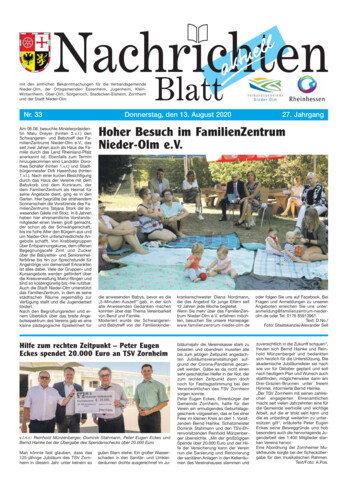

![Fachforum Kulturelle Diversität [Schreibgeschützt]](/img/31/forum2-nieder-k-rtner-kulturelle-diversit-t-und-integration-gefl-chteter-kinder-im-vorschulalter.jpg)
